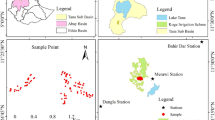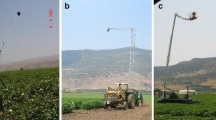Abstract
Crop coefficients are a widely used and universally accepted method for estimating the crop evapotranspiration (ETc) component in irrigation scheduling programs. However, uncertainties of generalized basal crop coefficient (K cb) curves can contribute to ETc estimates that are substantially different from actual ETc. Limited research with corn has shown improvements to irrigation scheduling due to better water-use estimation and more appropriate timing of irrigations when K cb estimates derived from remotely sensed multispectral vegetation indices (VIs) were incorporated into irrigation-scheduling algorithms. The purpose of this article was to develop and evaluate a K cb estimation model based on observations of the normalized difference vegetation index (NDVI) for a full-season cotton grown in the desert southwestern USA. The K cb data used in developing the relationship with NDVI were derived from back-calculations of the FAO-56 dual crop coefficient procedures using field data obtained during two cotton experiments conducted during 1990 and 1991 at a site in central Arizona. The estimation model consisted of two regression relations: a linear function of K cb versus NDVI (r 2=0.97, n=68) used to estimate K cb from early vegetative growth to effective full cover, and a multiple regression of K cb as a function of NDVI and cumulative growing-degree-days (GDD) (r 2=0.82, n=64) used to estimate K cb after effective full cover was attained. The NDVI for cotton at effective full cover was ~0.80; this value was used to mark the point at which the model transferred from the linear to the multiple regression function. An initial evaluation of the performance of the model was made by incorporating K cb estimates, based on NDVI measurements and the developed regression functions, within the FAO-56 dual procedures and comparing the estimated ETc with field observations from two cotton plots collected during an experiment in central Arizona in 1998. Preliminary results indicate that the ETc based on the NDVI-K cb model provided close estimates of actual ETc.









Similar content being viewed by others
References
Allen RG, Pereira LS, Raes D, Smith M (1998) Crop evapotranspiration. (FAO irrigation and drainage paper 56) Food and Agricultural Organization of the United Nations, Rome
Bausch WC (1995) Remote sensing of crop coefficients for improving the irrigation scheduling of corn. Agric Water Manage 27:55–68
Bausch WC, Neale CMU (1987) Crop coefficients derived from reflected canopy radiation: a concept. Trans ASAE 30(3):703–709
Bausch WC, Neale CMU (1989) Spectral inputs improve corn crop coefficients and irrigation scheduling. Trans ASAE 32(6):1901–1908
Brown PW (1989) Accessing the Arizona Meteorological Network (AZMET) by computer. (Ext rep 8733) The University of Arizona, Tucson
Brown PW (1991) Normal values of heat unit accumulation for southern Arizona. (Ext rep 190041) The University of Arizona, Tucson
Choudhury BJ, Amhed NU, Idso SB, Reginato RJ, Daughtry CS (1994) Relations between evaporation coefficients and vegetation indices studied by model simulations. Remote Sensing Environ 50:1–17
Colaizzi PD, Barnes EM, Clarke TR, Choi CY, Waller PM (2003) Estimating soil moisture under low frequency surface irrigation using the CWSI. J Irrig Drain Eng 129:27–35
Doorenbos J, Pruitt WO (1977) Crop water requirements. (FAO irrigation and drainage paper 24) Food and Agricultural Organization of the United Nations, Rome
Heilman JL, Heilman WE, Moore DG (1982) Evaluating the crop coefficient using spectral reflectance. Agron J 74:967–971
Hendrey GR, Kimball BA (1994) The FACE program. Agric For Meteorol 70:3–14
Howell TA, Evett SR, Tolk JA, Schneider AD (2002) Evapotranspiration of full-, deficit-irrigated and dryland cotton on the Northern Texas high plains. In: Burt CM, Anderson SS (eds) Energy, climate, environment, and water: Proceedings of the US committee on irrigation and drainage/EWRI conference, 9–12 July, San Luis Obispo, California. USCID, Denver, Colo., pp 321–329
Hunsaker DJ (1999) Basal crop coefficients and water use for early maturity cotton. Trans ASAE 42(4):927–936
Hunsaker DJ, Hendrey GR, Kimball BA, Lewin KF, Mauney JR, Nagy J (1994) Cotton evapotranspiration under field conditions with CO2 enrichment and variable soil moisture regimes. Agric For Meteorol 70:247–258
Hunsaker DJ, Pinter PJ Jr, Cai H (2003) Alfalfa basal crop coefficients for FAO-56 procedures in the desert southwestern US. Trans ASAE 45(6):1799–1815
Jackson RD, Huete AR (1992) Interpreting vegetation indices. Prev Vet Med 11:185–200
Jackson RD, Idso SB, Reginato RJ, Pinter PJ Jr (1980) Remotely sensed crop temperatures and reflectances as inputs to irrigation scheduling. In: Irrigation and drainage special conference proceedings, 23–25 July, Boise, Idaho. ASCE, New York, pp 390–397
Jensen ME, Allen RG (2000) Evolution of practical ET estimating methods. In: Evans RG, Benham BL, Trooien TP (eds) Proceedings of the 4th decennial national irrigation symposium, 14–16 Nov 2000, Phoenix, Arizona. ASAE, St Joseph, Mich., pp 52–65
Jensen ME, Burman RD, Allen RG (1990) Evapotranspiration and irrigation water requirements. (Manuals and reports on engineering practices no. 70) ASCE, New York
Mauney JR, Kimball BA, Pinter PJ Jr, LaMorte RL, Lewin KF, Nagy J, Hendrey GR (1994) Growth and yield of cotton in response to a free-air carbon dioxide enrichment (FACE) environment. Agric For Meteorol 70:31–48
Moran MS, Mass SJ, Pinter PJ Jr (1995) Combining remote sensing and modeling for estimating surface evaporation and biomass production. Remote Sensing Rev 12:335–353
Neale CMU, Bausch WC, Heerman DF (1989) Development of reflectance-based crop coefficients for corn. Trans ASAE 32(6):1891–1899
Pinter PJ Jr, Kimball BA, Mauney JR, Hendrey GR, Lewin KF, Nagy J (1994) Effects of free-air carbon dioxide enrichment on PAR absorption and conversion efficiency by cotton. Agric For Meteorol 70:209–230
Pinter PJ Jr, Kimball BA, Garcia RL, Wall GW, Hunsaker DJ, LaMorte RL (1996) Free-air CO2 enrichment: responses of cotton and wheat crops. In: Koch GW, Mooney HA (eds) Terrestrial ecosystems: responses to elevated carbon dioxide. Academic Press, Orlando, Fla., pp 215–249
Slack DC, Martin EC, Sheta AE, Fox F Jr, Clark LJ, Ashley RO (1996) Crop coefficients normalized for climatic variability with growing-degree-days. In: Camp CR, Sadler EJ, Yoder RE (eds) Evapotranspiration and irrigation scheduling: Proceedings of an international conference, 3–6 November 1996, San Antonio, Texas. ASAE, St Joseph, Mich., pp 892–898
Stegman EC (1988) Corn crop curve comparison for the Central and Northern Plains of the US. Appl Eng Agric 4(3):226–233
Tolk JA, Howell TA (2001) Measured and simulated evapotranspiration of grain sorghum grown with full and limited irrigation in three high plains soils. Trans ASAE 44(6):1553–1558
Author information
Authors and Affiliations
Corresponding author
Additional information
Communicated by R. Evans
Rights and permissions
About this article
Cite this article
Hunsaker, D.J., Pinter, P.J., Barnes, E.M. et al. Estimating cotton evapotranspiration crop coefficients with a multispectral vegetation index. Irrig Sci 22, 95–104 (2003). https://doi.org/10.1007/s00271-003-0074-6
Received:
Accepted:
Published:
Issue Date:
DOI: https://doi.org/10.1007/s00271-003-0074-6




